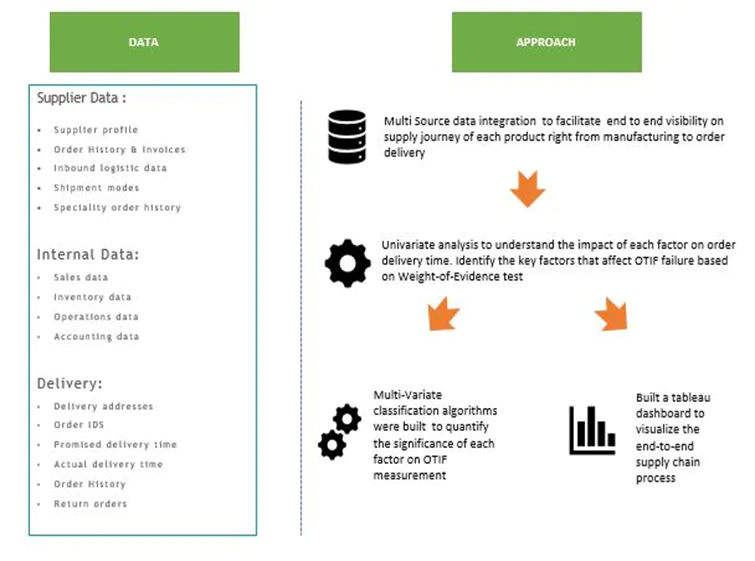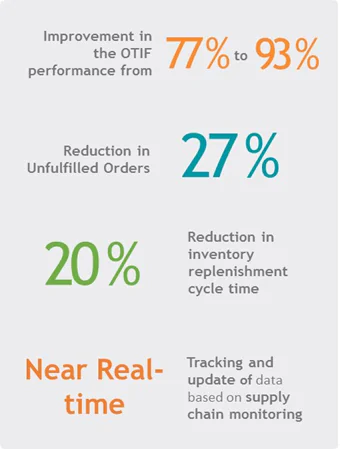Table of Contents
What You’ll Find in this Case Study:
- About the Client
- Inventory Replenishment Analytics Business Challenge and Quantzig’s Approach
- Business Benefits and Insights
About the Client
A well-executed on-time-in-full (OTIF) strategy is essential for organizations to deliver what exactly their customers want. With today’s fierce margin pressure, getting it right the first time improves organization’s service and lowers cost. To effectively achieve high customer satisfaction, there is a strict need for OTIF compliance. To have a higher OTIF measurement, businesses need to consider capacity planning, sales, procurement, inventory management, and order fulfilment as a bundle.
Inventory Replenishment Analytics Business Challenge and Quantzig’s Approach
With a keen eye on identifying potential growth opportunities, the client, a leading consumer goods manufacturer, and retailer based out of the US approached Quantzig to develop an effective solution model to enhance end-to-end supply chain visibility to achieve high customer satisfaction during order fulfillment. Due to low supply chain visibility, there was a dire need to identify factors affecting OTIF failure. The entire product life cycle right from manufacturing until customer fulfillment was analyzed in order to identify such gaps.
Contact us to gain detailed insights into our portfolio of supply chain analytics solutions.
The primary objective of this supply chain analytics study was to identify the key optimization areas to ensure that the OTIF is greater than 90% during the year 2017-2018. Additionally, we also developed a solution for end-to-end supply chain visibility and identify the areas of optimization to ensure greater OTIF delivery.
To cater to the specific requirements of the client, our supply chain analytics team collaborated with the client to develop a solution based on the analysis of historic data and investigated the reasons for OTIF failures. Moreover, to understand business requirements better, our team also collected information on various dimensions including internal data such as sales data, inventory data, and operations data.
Supply chain analytics can help improve logistics and fulfillment operations across industries. Wonder how? Request a FREE proposal.
Business Benefits and Insights
With the objective to help the leading consumer goods manufacturer and retailer enhance end-to-end supply chain visibility for their products, Quantzig deployed a team of experts to perform a supply chain analytics assessment. The solutions offered strategies to overcome the challenges that were affecting OTIF failure. With the help of our supply chain analytics algorithms, the leading consumer goods manufacturer and retailer was able to identify key factors to ensure that the OTIF was greater than 90% during the period of 2017-2018.
Want to know more about our business intelligence solutions that designed o improve supply chain visibility? Request more information.
A real-time tableau dashboard was created to visualize the end-to-end supply chain process. Univariate data analysis was also carried out to help the client understand the impact of each factor on order delivery time and identify the key factors that affect OTIF failure based on the weight-of-evidence test. Moreover, multi-source data integration facilitated the end to end visibility on the supply journey of each product right from manufacturing to order delivery. By analyzing various datasets for inbound, internal, and outbound data, the team segregated the factors influencing OTIF measurement to supplier attributes, internal, and delivery attributes.
In a span of just twelve weeks, the solutions helped track the product’s journey right from manufacturing, receiving, picking, staging, loading, delivery, till invoicing on a real-time basis. With the help of our supply chain analytics solutions, the team re-strategize the sourcing locations by analyzing the Impact of supplier location and transit times on the design-to-market time of a product. Our supply chain solution also Improve demand forecasting efficiency post automation of the sales-order process, which was one the crucial recommendation from OTIF failure investigation.




